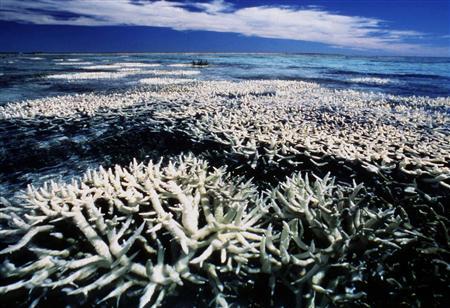Storms to starfish: Great Barrier Reef faces rapid coral loss: study
Date: 02-Oct-12
Country: SINGAPORE
Author: David Fogarty

Coral on Australia's Great Barrier Reef can be seen suffering from
bleaching in this April 25, 1998 file handout photo. The world's
largest coral reef - under threat from Australia's surging coal and
gas shipments, climate change and a destructive starfis
Photo: Handout/Files
The world's largest coral reef - under threat from Australia's surging coal and gas shipments, climate change and a destructive starfish - is declining faster than ever and coral cover could fall to just 5 percent in the next decade, a study shows.
Researchers from the Australian Institute of Marine Science (AIMS) in the northeastern city of Townsville say Australia's Great Barrier Reef has lost half of its coral in little more than a generation. And the pace of damage has picked up since 2006.
Globally, reefs are being assailed by myriad threats, particularly rising sea temperatures, increased ocean acidity and more powerful storms, but the threat to the Great Barrier Reef is even more pronounced, the AIMS study published on Tuesday found.
"In terms of geographic scale and the extent of the decline, it is unprecedented anywhere in the world," AIMS chief John Gunn told Reuters.
AIMS scientists studied data from more than 200 individual reefs off the Queensland coast covering the period 1985-2012. They found cyclone damage caused nearly half the losses, crown-of-thorns starfish more than 40 percent and coral bleaching from spikes in sea temperatures 10 percent.
The starfish are native and prey on the reefs. But plagues are occurring much more frequently.
Ordinarily, reefs can recover within 10 to 20 years from storms, bleachings or starfish attacks but climate change impacts slow this down. Rising ocean acidification caused by seas absorbing more carbon dioxide is disrupting the ability of corals to build their calcium carbonate structures. Hotter seas stress corals still further.
Greens say the 2,000 km (1,200 mile) long reef ecosystem, the center-piece of a multi-billion tourism industry, also faces a growing threat from shipping driven by the planned expansion of coal and liquefied natural gas projects.
Those concerns have put pressure on the authorities to figure out how to protect the fragile reef.
FALLING FAST
The researchers say the pace of coral loss has increased since 2006 and if the trend continues, coral cover could halve again by 2022, with the southern and central areas most affected.
Between 1985 and 2012, coral cover of the reef area fell from 28 percent to 13.8 percent.
"Coral cover on the reef is consistently declining, and without intervention, it will likely fall to 5 to 10 percent within the next 10 years," say the researchers in the study published in the Proceedings of the National Academy of Sciences journal. They called for tougher curbs on greenhouse gas emissions as a crucial way to stem the loss.
Shipping and new ports on the Queensland coast are another major threat, Greenpeace says.
Coal is one of Australia's top export earners and the state of Queensland is the country's largest coal-producer. It also has a rapidly growing coal-seam gas industry for LNG exports.
Earlier this year, Greenpeace estimated port expansion could more than triple Queensland's coal export capacity by 2020 from 257 million metric tons (283.29 million tons) now. That would mean as many as 10,000 coal ships per year could make their way through the Great Barrier Reef area by 2020, up 480 percent from 1,722 ships in 2011, according to the group.
The Queensland and national governments, which jointly manage the reef, have launched a major review of managing the risks facing the UNESCO-listed reef and its surrounding marine area. The review will look at managing the threats from increased shipping to urban development.
Gunn said better management was all about buying time and improving the reef's resilience to climate change. A key area was improving water quality from rivers flowing into the reef area, with studies suggesting fertilizer-rich waters help the crown-of-thorns starfish larvae rapidly multiply.
(Editing by Jeremy Laurence)
![]()
© Thomson Reuters 2012 All rights reserved